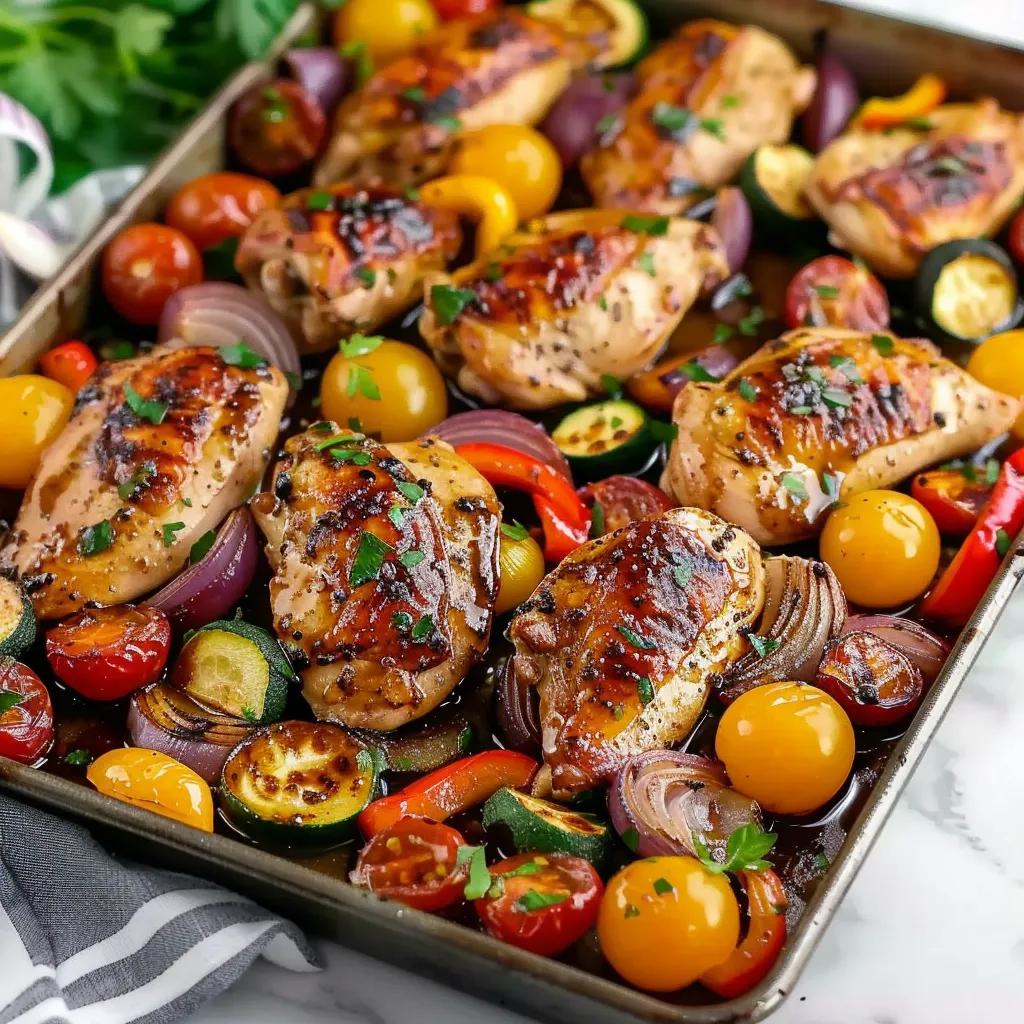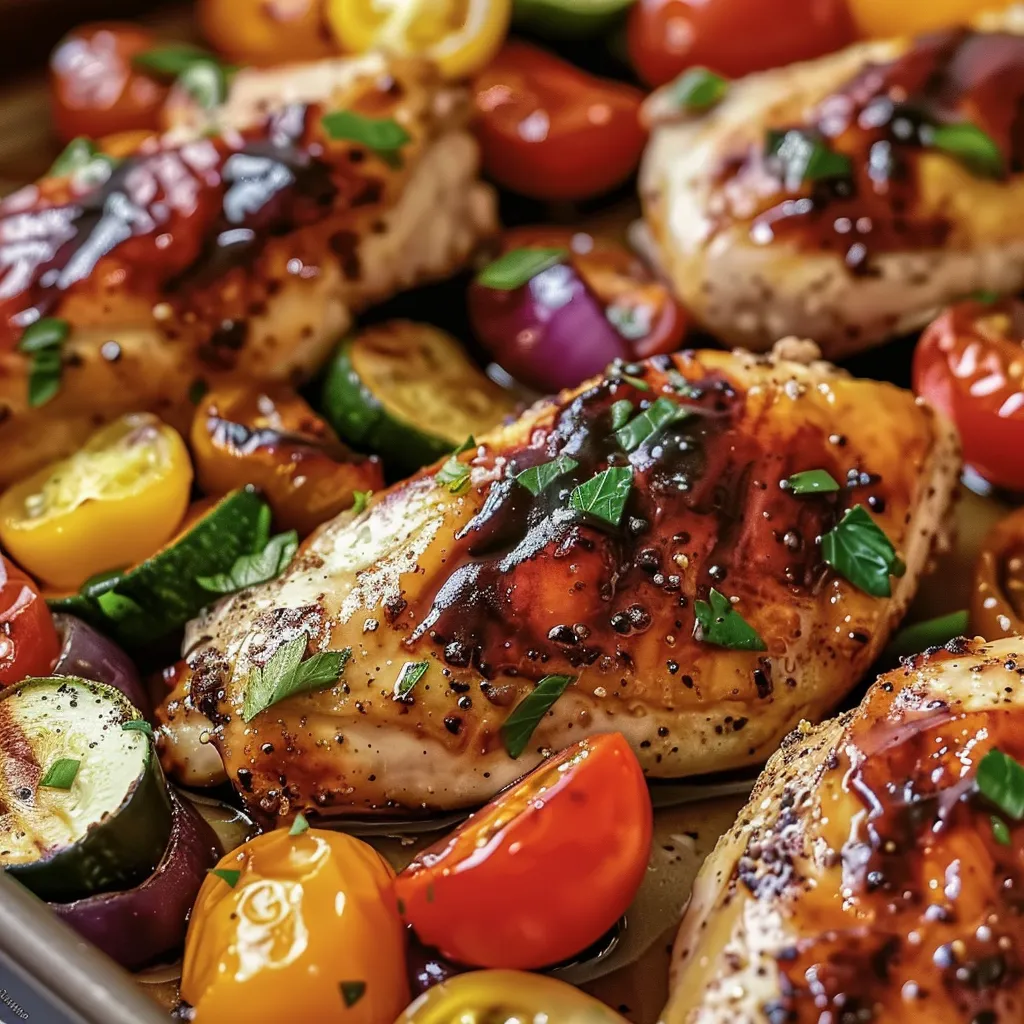 Bookmark
Bookmark
This one-pan balsamic glazed chicken and veggies recipe transforms simple ingredients into a restaurant-worthy dinner with minimal cleanup. The sweet and tangy balsamic glaze caramelizes in the oven, creating a mouthwatering coating on both the tender chicken and colorful vegetables.
I discovered this recipe during a particularly hectic month when I needed quick yet nutritious dinners. My family was immediately hooked by the rich flavor and now it appears on our meal plan at least twice a month.
Ingredients
- Boneless skinless chicken breasts these stay juicy and cook quickly choose organic if possible for best flavor
- Mixed vegetables bell peppers zucchini and red onion add color nutrition and absorb the delicious glaze
- Balsamic vinegar use a good quality one as it forms the foundation of your glaze darker and thicker varieties work best
- Olive oil helps the vegetables roast properly and adds richness to the glaze
- Honey balances the acidity of the vinegar with natural sweetness
- Garlic minced provides essential aromatic flavor choose fresh over jarred for optimal taste
- Salt and pepper the classics that enhance all the other flavors
- Fresh basil optional but adds a beautiful pop of color and fresh flavor at the end
Step-by-Step Instructions
- Preheat Oven
- Turn your oven to 400°F and position a rack in the center. This high temperature will help caramelize the balsamic glaze while ensuring the chicken cooks through perfectly without drying out.
- Prepare Balsamic Glaze
- In a small bowl combine the balsamic vinegar olive oil honey minced garlic salt and pepper. Whisk thoroughly until the honey is fully incorporated and the mixture looks uniform. This glaze is the star of the dish so take your time ensuring everything is well blended.
- Arrange Chicken
- Place chicken breasts on a rimmed baking sheet ensuring they aren't touching each other. Pour half of your prepared balsamic mixture over the chicken making sure to coat each piece evenly. The chicken will absorb these flavors as it cooks.
- Add Vegetables
- Distribute the mixed vegetables around the chicken pieces on the same pan. Pour the remaining balsamic mixture over the vegetables and use your hands or tongs to toss them gently ensuring they're evenly coated with the glaze.
- Bake to Perfection
- Place the sheet pan in your preheated oven and bake for 25 to 30 minutes. The chicken is done when it reaches an internal temperature of 165°F and the vegetables should be tender but not mushy. The balsamic mixture will have thickened into a beautiful glaze.
- Garnish and Serve
- Remove from the oven and let rest for 5 minutes. This allows the juices to redistribute within the chicken. Sprinkle with torn fresh basil leaves if using and serve while still warm for the best flavor experience.
 Bookmark
Bookmark
The balsamic vinegar is truly the heart of this recipe. I once tried to substitute regular vinegar when I ran out of balsamic and the results were completely different. The depth and natural sweetness that good quality balsamic brings to this dish creates a complexity that belies how simple it is to prepare.
Choosing the Best Balsamic Vinegar
Not all balsamic vinegars are created equal. For this recipe I recommend using a moderately priced balsamic that has some thickness to it. True balsamic vinegar from Modena Italy will give you the best results but there are many good quality options available in most supermarkets. Look for one that coats the side of the bottle when swirled and has a balanced sweet-tart flavor profile. The better your balsamic the richer your final glaze will be.
Vegetable Variations
This recipe shines with its adaptability to whatever vegetables you have on hand. While the bell peppers zucchini and red onion create a colorful Mediterranean palette you can easily substitute with broccoli cauliflower carrots or Brussels sprouts during cooler months. Just ensure harder vegetables like carrots are cut slightly smaller to ensure even cooking. Cherry tomatoes added for the last 10 minutes of cooking will burst and add a wonderful juicy element to the finished dish.
Make Ahead Options
This recipe works beautifully for meal planning. You can prepare the balsamic marinade up to three days in advance and store it in an airtight container in the refrigerator. You can also chop all vegetables and store them in a separate container. When ready to cook simply arrange everything on your sheet pan pour over the marinade and bake. Alternatively the entire dish can be cooked and portioned into containers for quick lunches and dinners throughout the week.
Recipe FAQs
- → Can I use chicken thighs instead of breasts?
Yes, boneless chicken thighs work beautifully in this dish and often result in juicier meat. You may need to adjust cooking time slightly—thighs typically take 5-7 minutes longer than breasts. Use a meat thermometer to ensure they reach 165°F (74°C).
- → What other vegetables work well with this glaze?
This versatile glaze pairs wonderfully with many vegetables. Try cherry tomatoes, broccoli florets, cauliflower, carrots, Brussels sprouts, or asparagus. Just adjust cooking times for denser vegetables by cutting them smaller or giving them a head start in the oven.
- → Can I make this ahead of time?
Yes! You can prepare the balsamic mixture up to 3 days ahead and store it in the refrigerator. You can also slice all vegetables and store them separately. For maximum flavor, marinate the chicken in the balsamic mixture for 2-8 hours before cooking.
- → Is there a way to make this dish without honey?
Absolutely. Maple syrup makes an excellent substitute with a slightly different flavor profile. Brown sugar or agave nectar also work well to achieve that sweet-savory balance in the glaze.
- → What's the best way to serve this dish?
This one-pan meal is delicious on its own, but also pairs wonderfully with quinoa, brown rice, or crusty bread to soak up the extra glaze. For a lower-carb option, serve over cauliflower rice or with a simple green salad dressed with olive oil and lemon juice.
- → How can I make the balsamic glaze thicker?
For a thicker glaze, remove the chicken and vegetables once cooked, then pour the pan juices into a small saucepan. Simmer over medium heat for 5-7 minutes until reduced and syrupy. Alternatively, mix 1 teaspoon cornstarch with 1 tablespoon cold water and add to the warm pan juices, stirring until thickened.
